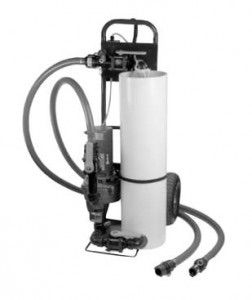I've done plenty of coolant flushes in mostly the automotive and powersports world, but usually I do it is as PM instead of a response to a problem.
My Kubota L305DT is getting warm when at PTO Operating speed and tends to stay up there until I throttle back and reduce the load. I've had a slight amount of coolant boil over and after inspecting the radiator, the cores look to be a bit scaled up and in need of a good cleaning. So my question is - who has used what and what do people recommended? I'm looking for a chemical additive (or different process than garden hose flush) to aid in getting the cooling system clean and operating efficiently again.
There's a bunch of different home remedies and off the shelf "mechanic in a bottle" solutions so lets here some opinions!
so lets here some opinions!
To cover the bases about the overheating, here's what I know about the situation:
-Screen and fins are clear
-Haven't pulled the thermostat, but this isn't suspect because the temps regulate back to normal and stay there. I can also sustain the "high temp" where it is at based on load and always bring it back down by unloading the tractor. I could always pull it and check it on the stove, but I need to clean the system regardless
-Water pump appears to be circulating coolant through the radiator properly, whether it's "up to spec" or not, I can't verify. I am doubtful this is the problem.
-Head gasket isn't in the mix as I'm not getting coolant in the oil/white smoke out the exhaust/black floaties in the coolant/or over-pressurization of the coolant from combustion gases
-Have checked temps with a different gauge and am getting up to about ~220F before I start lowering the load. It probably could go higher, but i don't push it at that point
-Oil has been changed recently and is still clean (not overheating from the engine oil)
My Kubota L305DT is getting warm when at PTO Operating speed and tends to stay up there until I throttle back and reduce the load. I've had a slight amount of coolant boil over and after inspecting the radiator, the cores look to be a bit scaled up and in need of a good cleaning. So my question is - who has used what and what do people recommended? I'm looking for a chemical additive (or different process than garden hose flush) to aid in getting the cooling system clean and operating efficiently again.
There's a bunch of different home remedies and off the shelf "mechanic in a bottle" solutions
To cover the bases about the overheating, here's what I know about the situation:
-Screen and fins are clear
-Haven't pulled the thermostat, but this isn't suspect because the temps regulate back to normal and stay there. I can also sustain the "high temp" where it is at based on load and always bring it back down by unloading the tractor. I could always pull it and check it on the stove, but I need to clean the system regardless
-Water pump appears to be circulating coolant through the radiator properly, whether it's "up to spec" or not, I can't verify. I am doubtful this is the problem.
-Head gasket isn't in the mix as I'm not getting coolant in the oil/white smoke out the exhaust/black floaties in the coolant/or over-pressurization of the coolant from combustion gases
-Have checked temps with a different gauge and am getting up to about ~220F before I start lowering the load. It probably could go higher, but i don't push it at that point
-Oil has been changed recently and is still clean (not overheating from the engine oil)


